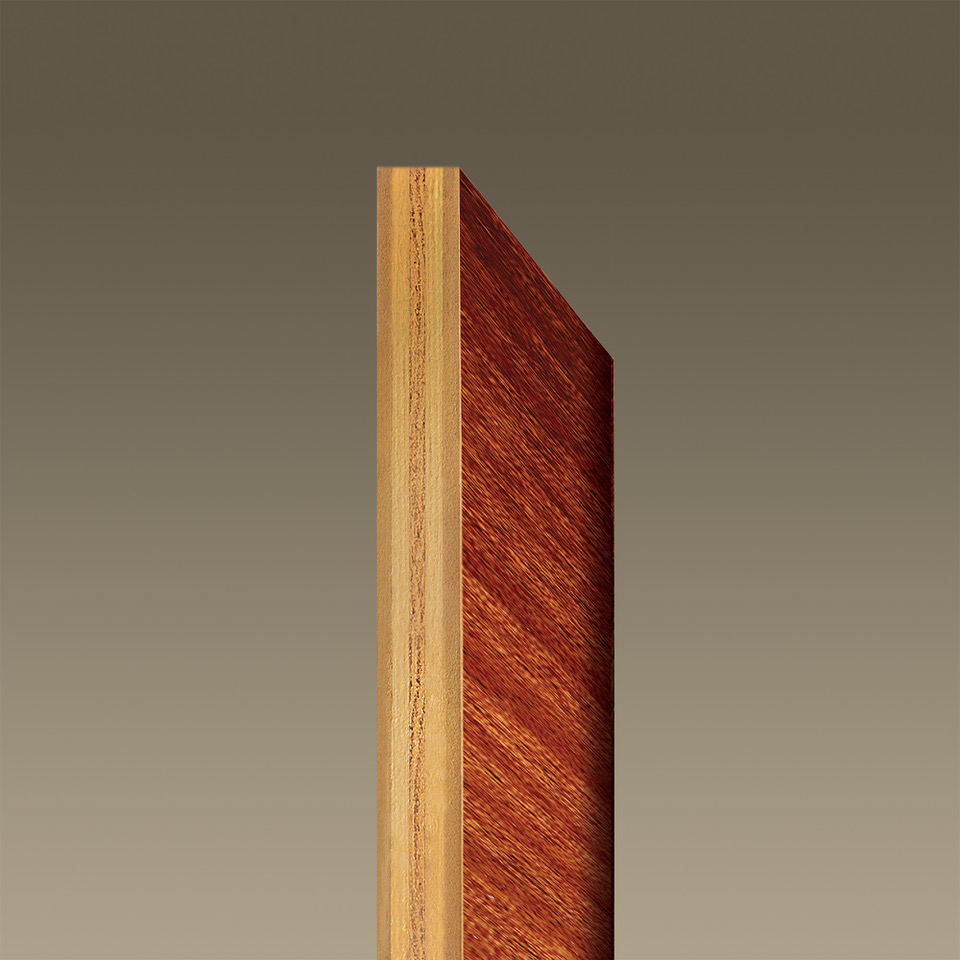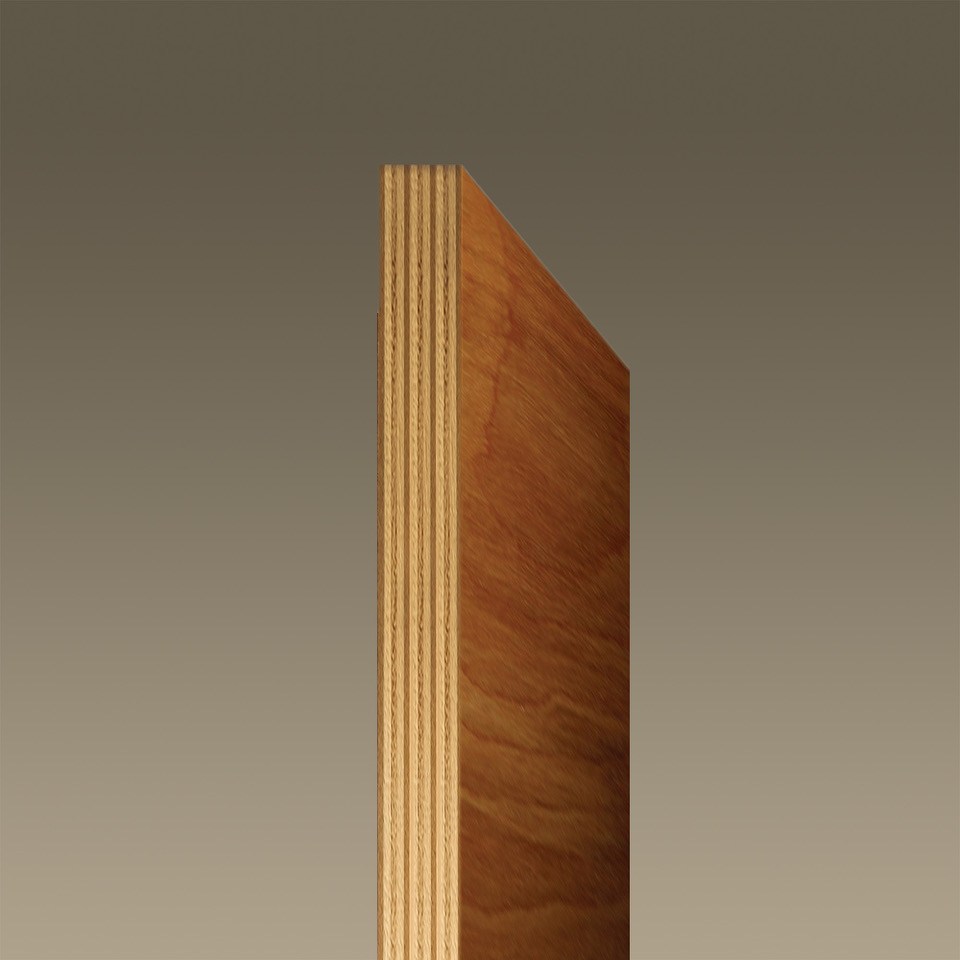COMPARE CORES
Choose Your Substrate
When you order hardwood plywood from States Industries, you can choose the type of core or “substrate” used in assembling your panel products. The substrate is the base material over which thin decorative face and back veneers are applied. Core selection is often a balance between performance characteristics and price.
Three Common Types of Cores



Core Types

Veneer Core
Veneer core is comprised of wood veneers laminated in alternating directions to achieve the desired panel thickness. Generally, the higher number of plies used, the better the core. Veneer core panels are lightweight and hold screws better than most other substrates. They are also high in dimensional stability and bending strength. Veneer core panels may be laminated in one step for maximum economy or constructed and sanded to a metered tolerance using a two-step laminating process.
Attributes of 2-Step Veneer Core
Flatness
Visual Edge
Surface Uniformity
Dimensional Stability
Screw Hiding
Bending Strength
Thickness Tolerance
Cost
ApplePly®: Premium Hardwood Panels
ApplePly is States’ highest quality, veneer core panel, constructed from 1/16” Birch using a two-step lamination process. Because the innerplies are thin, uniform hardwood veneers, ApplePly machines beautifully. ApplePly is specified for its attractive edge, high strength and solid hardwood core. It is widely used in retail fixtures, contemporary furniture and architectural interiors, where its attractive edge is incorporated as a design element.
Attributes of ApplePly
FLATNESS
VISUAL EDGE
SURFACE UNIFORMITY
DIMENSIONAL STABILITY
SCREW HIDING
BENDING STRENGTH
THICKNESS TOLERANCE
Cost


ArmorCore®: Combination Core
ArmorCore is a hybrid substrate, combining composite crossbands with veneer innerplies to produce an exceptionally flat, smooth surface. ArmorCore is preferred in applications where panels need to have the weight, structural value and screw-holding ability of veneer core with the superior flatness and higher density of MDF. ArmorCore is offered in one-step and two-step construction for maximum flexibility.
Attributes of 2-Step ArmorCore
FLATNESS
VISUAL EDGE
SURFACE UNIFORMITY
DIMENSIONAL STABILITY
SCREW HIDING
BENDING STRENGTH
THICKNESS TOLERANCE
Cost
Composite Core
Composite core panels include particleboard and MDF of several densities. Composite cores are valued for their flat, smooth surfaces and tight tolerances, as well as their relatively low costs. MDF is available in both thin and thick versions, and its more refined particles improve its machinability. Particleboard is available in thicknesses above 7/16” and is the lowest cost substrate used in hardwood plywood.
Attributes of MDF
FLATNESS
VISUAL EDGE
SURFACE UNIFORMITY
DIMENSIONAL STABILITY
SCREW HIDING
BENDING STRENGTH
THICKNESS TOLERANCE
Cost

One-step vs Two-step construction
In conventional one-step hardwood plywood layup, all veneers—including the face and back—are laminated at one time. Two-step layup means that the inner plies are first laminated into a “blank” and any surface knots or splits are puttied. The blank is then sanded to a calibrated tolerance and overlaid with face and back veneers. The advantages of using the more expensive two-step construction are the smoothness of the surface and the consistency of the panel’s thickness.

Compare Core Attributes
Flatness
1-Step Veneer
2-Step Veneer
ApplePly
1-Step Armorcore
2-Step Armorcore
MDF
Particleboard
Visual Edge
1-Step Veneer
2-Step Veneer
ApplePly
1-Step Armorcore
2-Step Armorcore
MDF
Particleboard
Surface Uniformity
1-Step Veneer
2-Step Veneer
ApplePly
1-Step Armorcore
2-Step Armorcore
MDF
Particleboard
Dimensional Stability
1-Step Veneer
2-Step Veneer
ApplePly
1-Step Armorcore
2-Step Armorcore
MDF
Particleboard
Screw Hiding
1-Step Veneer
2-Step Veneer
ApplePly
1-Step Armorcore
2-Step Armorcore
MDF
Particleboard
Bending Strength
1-Step Veneer
2-Step Veneer
ApplePly
1-Step Armorcore
2-Step Armorcore
MDF
Particleboard
Thickness Tolerance
1-Step Veneer
2-Step Veneer
ApplePly
1-Step Armorcore
2-Step Armorcore
MDF
Particleboard
Cost
1-Step Veneer
2-Step Veneer
ApplePly
1-Step Armorcore
2-Step Armorcore
MDF
Particleboard
How Innerplies Impact Panel Quality
Number of plies
Generally, the more plies used in a panel of the same thickness means that the volume of open knots in each layer of veneer is reduced because the veneers are thinner. In laminating, the adjoining veneers will compress somewhat into any voids, further minimizing their impact on the panel.
Species and grade
The strength, color, machinability and level of defect in a finished panel directly reflect the species and grade of the innerply material. Higher grade and lighter color crossbands, such as Lauan or hardwood, are options that can be specified for the layers directly under the face and back veneers.
